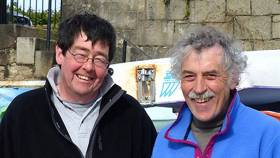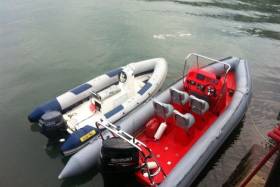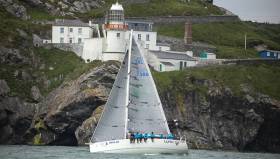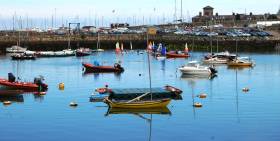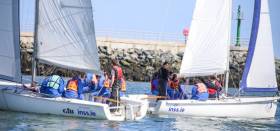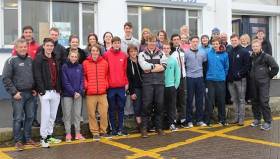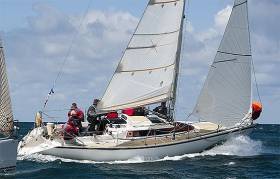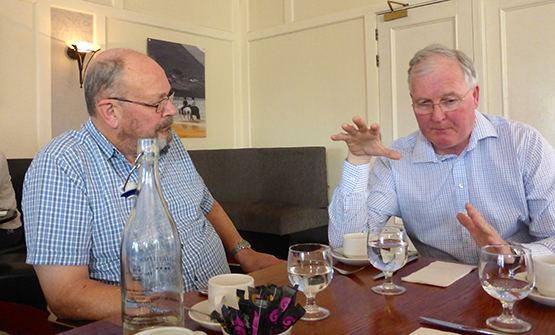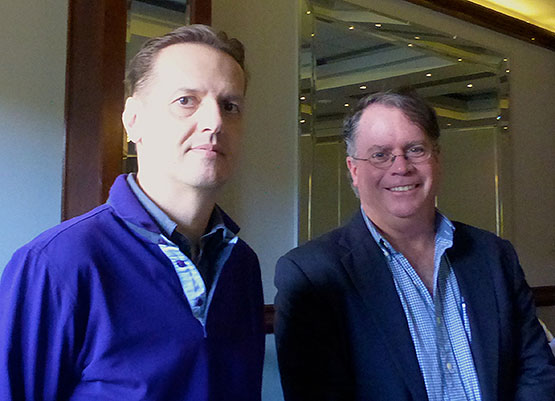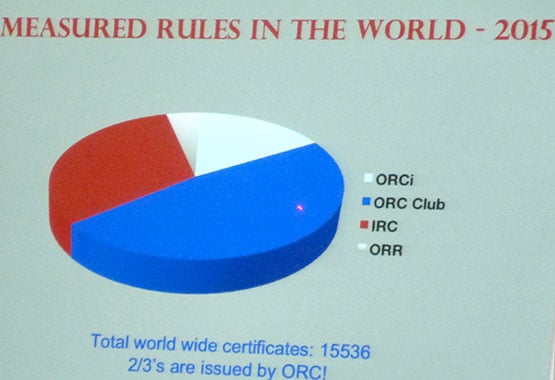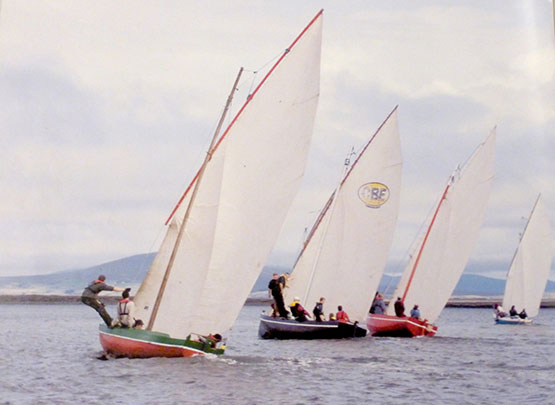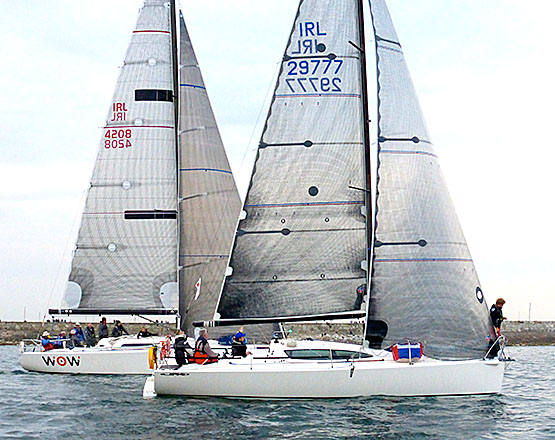Displaying items by tag: Irish National Sailing School
Arthur Rumball 1961–2016
When we remember that Arthur Rumball was one of the definitive backroom boys of the Irish maritime world, it is remarkable and heart-warming to reflect on just how many lives he influenced for the better, and how many young people – aspiring sailors and would-be boatbuilders alike – he helped guide towards sailing and career fulfillment.
In his professional life, his work lives on in Viking Marine, while he was the main force in keeping the Irish National Sailing School’s fleet operational. In any size of business operation functioning within the challenges and restraints of the Irish market and our sometimes decidedly quirky sailing world, that would have been a demanding task. But these days the INSS fleet numbers 250 vessels in all, ranging from tiny dinghies up to 1720s and three fully-fledged offshore yachts. Yet in each case, Arthur could be relied on to assess exactly the right level of maintenance and finish required to keep the boat at the optimum level for the task for which it was required, and he did it with a minimum of fuss utilising sometimes very basic facilities.
He was the younger brother of INSS’s founding father Alistair Rumball by seven years, but as there were only the two siblings in this Malahide sailing family, inevitably they shared many experiences, although their sailing careers were to diverge during the period when the age gap seemed at its widest.
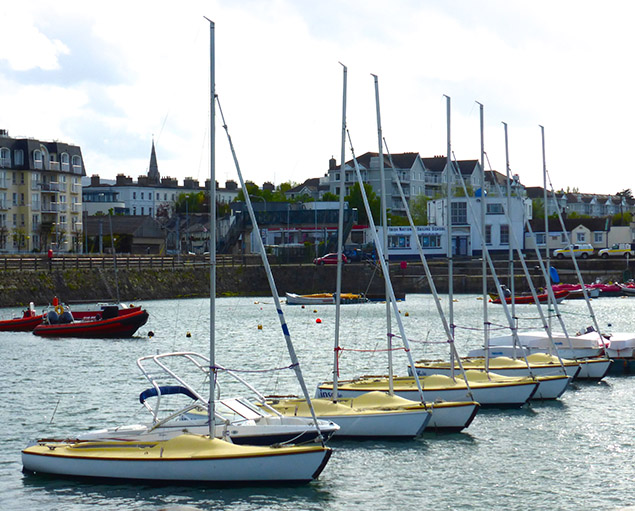
However, after Alistair began operations with the Irish National Sailing School with a sailing dinghy or two launching from the public slip in the Coal Harbour in Dun Laoghaire in 1974, Arthur helped now and again on a part-time basis, but by 1980 he was working with Alistair full-time with the INSS and their retail outlet Viking Marine.
Much and all as the brothers had enjoyed an idyllic Malahide childhood, as they both had business training they readily accepted that the greater density of population and affluence meant that any commercial sailing school, with its supporting shop, would have to be Dun Laoghaire-based. Over the years they have introduced thousands of people to sailing in a friendly, non-fussy way which nevertheless turned out hundreds of competent sailors, and reached a new height in 2016 when the INSS’s Reflex 38 Lynx – skippered by Alistair’s son Kenneth - was the top school boat in the Volvo Round Ireland Race, placing 10th overall in a very competitive fleet of 63 boats.

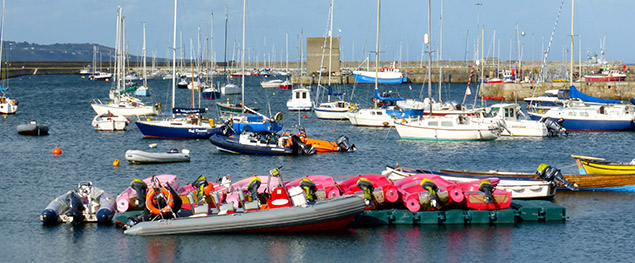
But that was only the peak of an astonishingly varied range of activities, all of which were supported by the ready availability of a fleet of boats whose maintenance Arthur oversaw and took an active involvement in working with. Indeed, there were few in the Irish boat-building and repair business who could rival Arthur’s breadth of experience and ability. His determinedly can-do approach – a Rumball family characteristic – was as inspiring ashore as his colleagues efforts afloat were in developing a practical “get-on-with-it” attitude to boats among those who benefitted from the INSS experience.
Despite his busy life around boats, Arthur had other interests and a very complete home life with Amanda and their three children, now all in their twenties. When it became known some time ago that he was battling gallantly with cancer, the thoughts of many worldwide were with him. And a shared hope was raised when it was known that the cancer had been cleared, even though a long struggle lay ahead for his weakened body to re-build itself.
Until a week ago, the outlook was promising, but then his condition suddenly deteriorated, and on Sunday, Arthur Rumball slipped quietly from among us all too soon at the age of 55. Our heartfelt condolences are with his family at this great loss which we share with his many friends, whose feelings have been best expressed both by Nick Bendon and his team in CH Marine, and by former colleague and pupil Rory Kelleher in Seattle.
From CH Marine, the message was: “From those early pioneering days of Dublin Boat Shows and Viking Marine, we always enjoyed his friendship and support, and while not wanting to use the word “legendary” too lightly, Arthur was that in our eyes, and a larger-than-life figure in the marine industry. This is the passing of a whole era, and we will miss him very much”.
Rory Kelleher spoke from the heart in a message to Alistair Rumball: “Please understand that he lives on in me, by the skills that he taught me. He is – as you are – one of the stones in the foundation of my life. And for that I am very grateful”.
WMN
 A long way from a sailing dinghy or two being launched from the public slip in Dun Laoghaire in 1974 ……the Irish National Sailing School’s Reflex 38 Lynx at the start of the Volvo Round Ireland Race 2016, in which she was winning sailing school boat, and tenth overall in a fleet of 63
A long way from a sailing dinghy or two being launched from the public slip in Dun Laoghaire in 1974 ……the Irish National Sailing School’s Reflex 38 Lynx at the start of the Volvo Round Ireland Race 2016, in which she was winning sailing school boat, and tenth overall in a fleet of 63
Motorboat Hire: Rent a RIB on Dublin Bay
Ever wanted to rent a Rigid Inflatable Boat (RIB) for a blast on Dublin Bay? Here's your chance. The Irish National Sailing School's 4.5m RIBTECs fitted with Yamaha 40hp engines are ideal for trips around the capital's waters. Included in the price of a three hour charter at €115 is a full tank of fuel.
The operating area for these boats is Dublin Bay, south of the shipping lane and as far East as Dalkey Island. The minimum qualification required to rent the boat is a National Powerboat Certificate (Level 2).
For more details on the offer check out the listing on Afloat's Marketplace here.
The Irish National Sailing School is offering new after schools learn to sail programmes for children of all ages. There are two new programmes available, an after schools club for children of all ages and our all new Wednesday afternoon’s transition year programme to allow children to tackle new challenges during transition year.
The after school club is specifically aimed for primary school children in the South Dublin locality as a facility to cater for supervised homework with the added bonus of a number of land and water activities. These activities include launch trips to feed the seals, some sailing if time allows or some on the water fun in our new water park. The INSS are also able to offer a collection service from local schools.
The Transition Year/Second Level programme is designed to help students make the transition from dinghy sailing to be competent on both racing and cruising yachts. With LYNX its highly successful racing yacht and Beaufort Venture, its dedicated cruising yacht the INSS says it is perfectly suited to both ends of the yachting spectrum. The programme will cover navigation, practical sailing skills on both yachts, use of VHF radio and can also include the National Powerboat Certificate course.
Of particular interest to many children and yacht owners alike will be the opportunity for children to undertake the keelboat and yacht racing module which will teach children all the skills, tricks and knowledge to be competent crews and helms on racing yachts and keelboats, This training will take place on 1720 keelboats and its offshore racing yacht LYNX.
The programme is modular in format allowing students to undertake different sections as they please. The programme in the perfect solution for young students to gain work towards obtaining the Gaisce President’s award. The programme will conclude with a weekend long passage on-board one of its yachts lasting from Friday afternoon until Sunday evening, again this is in keeping with the requirements of the Silver Gaisce Award. The destination of the trip will be up to the students, who will use their new found skills to plan and execute the voyage, all under the guidance of one of its Cruising Instructors.
Further information on the INSS website here
It was a glorious day in Dun Laoghaire. I could see young sailors clustered on boats around a pontoon. The sound of their enjoyment at being afloat drifted across the water. I was there because Alistair Rumball, who set up the Irish National Sailing School forty-four years ago, had talked to me about his concept of sail training when we met at the annual meeting of the Irish Cruiser Racing Association in Limerick.
I made a presentation there, urging clubs to improve access to the sport. While acknowledging my opinions and encouragement of the development of the ‘Try Sailing’ project by the Irish Sailing Association and expressing the hope that it would be successful in widening participation, I noted that Alistair had another approach, which he suggested I should “come and see.”
He told me that his school “had small beginnings but was now “the largest sail training provider in Ireland” and has provided training for 80,000 since it was established.
The Irish National Sailing & Powerboat School is based on the West Pier in Dun Laoghaire, to where it moved from its original base on the main street of Dun Laoghaire in 1991.
“We introduced more people to the water than any other organisation and pioneered low-cost course fees, which showed that sailing need not be an expensive sport.”
Following our chat in Limerick I was curious about the contrast between Alistair Rumball’s operation and the ISA Junior and adult courses offered through clubs and its ‘Try Sailing’ project and ‘Crew Point’.
Alistair Rumball was forthright to me in saying he had differences with the ISA about aspects of what it does. He made it clear to me that his operation has a commercial approach and its success is dependent upon the services which it provides and for which people were obviously prepared to pay and appreciated what was provided. INSS courses include junior, adult, schools, colleges, corporate sailing and race training.
It has a team of full-time instructors led by Alistair’s son, Kenneth, who is Manager and Chief Instructor. His sailing record includes offshore campaigns, the Fastnet, Sydney–Hobart and Rolex Middle Sea. I met him when I called to the INSS where, during our interview, he put emphasis on the enjoyment of sailing: “Use the boat to enjoy it. A fine balance between competition and enjoyment makes the sport enjoyable. Focussing too much on competition can be a barrier to enjoyment. The most important approach is to enjoy going sailing,” were amongst the points he made.
Listen to Kenneth Rumball on the Podcast below.
Read also: Dun Laoghaire Sailing's Cage Rattled By Malahide Boating Dynamo
Last Sunday, Dun Laoghaire's Irish National Sailing and Powerboat School held its 2016 Open Day in association with Irish Sailing Association's 'Try Sailing' programme.
50 new people to the sport experienced the thrill of sailing onboard a 1720 sportsboat while 64 people enjoyed kayaking and Paddle-Boarding. Check out the video below:
The Irish National Sailing & Powerboat School has been active this winter in anticipation of a busy summer season writes Principal Kenneth Rumball. Through various acquisitions the following additions to the INSS fleet have been made, 13 sit–on Kayaks, five double Kayaks, three rescue boats, 14 Laser Pico Training dinghies, 12 Topper dinghies, two topaz dinghies, three Topper Vibe dinghies, 10 Optimist dinghies and the purchase of another 6.5m fast RIB for our busy powerboat courses.
We have recognised a growing demand at the Irish National Sailing & Powerboat School and we are being proactive in our purchase of equipment ahead of what we hope will be a busier than ever season! Our latest additions show our commitment to continue to be the leading Sailing & Powerboat Training centre in Ireland catering for everybody from the novice power-boater or sailor in dinghies and yachts to a seasoned racer looking to upskill or the experienced power-boater looking to take his skill to the next level. With the current fleet size of sailing and powerboats in the INS&PS standing at over 200 boats, we certainly have the capacity to get everybody on the water.
Our new fleet of course requires more instructors and for this we have been busy training staff not only to fulfil the demands of the Irish National Sailing & Powerboat School but also of the country of Ireland. The Easter break was particularly busy with an ISA Dinghy Instructor Course run before the Easter weekend with 8 attendees and then after the Easter weekend we ran an RYA Dinghy Instructor Course with 18 attendees. We also ran possibly the first RYA Cruising Instructor Course to be held in Ireland over the break, training instructors to the level required to teach up to Day Skipper Practical level on the new ISA and RYA Cruising schemes. Not forgetting the other ISA Dinghy Instructor Courses, RYA Powerboat Instructor Courses that have already been run this year.
Here is a quote from one of our newest dinghy instructors;
“I'm just after completing my dinghy instructor course in the INSS and am so excited now to be able to pass on my skills to younger sailors and adults alike! The course was tiring at times but we all learnt so much and really enjoyed ourselves. It really was a fantastic week and year of training.” - Clodagh Quinn
Now that we have the extra boats and staff in place, we are gearing up for what we hope will be a busy and enjoyable summer.
The Irish Cruiser-Racer Association (ICRA) is a unique organisation. “Run by sailors for sailors”, it is nevertheless a very land-centric administrative body whose only manifestation afloat as a group with its own identity is seen at the organisation of the annual ICRA Nationals. And the sense of it relating purely to the island of Ireland is accentuated by the fact that much of its work is essentially back-office activity, dealing with handicaps and all the other paraphernalia involved in providing the nation’s numerous and very diverse cruiser-racer fleet with meaningful racing. W M Nixon went to last Saturday’s ICRA Conference to get a flavour of what ICRA does, and came away both impressed and stimulated.
Sweeping along southwestward towards Limerick on our wonderful motorway system, while one’s body stays firmly on the dual carriageway, the mind can wander into any pathways it wishes. So we got to thinking that, in this age of increasing numbers of administrators trained to third level degrees in the running of not-for-profit organisations, it’s a bit odd to find a very successfully central organisation which is apparently run – and well run at that - on a Corinthian basis “by sailors for sailors”.
Surely in today’s climate, which favours key bodies such as this being run by highly-trained specialists on at least a semi-professional basis, a seemingly amorphous organisation which is “run by sailors for sailors” is verging on a clear case of the asylum being taken over by the lunatics?
We’d soon see. Meanwhile, why on earth hold an annual conference in Limerick? With Ireland’s population distribution changing so rapidly, skewing both towards the large urban centres and particularly towards the east coast and Dublin, surely anyone organising a national conference would find it attendee-friendly to look at the latest map of population weighting. As it happens, I’m not sure that such a map exists, but we’d like to think that with today’s computers it is possible to construct a map where, after due calculation, you could pinpoint to the exact centre of Ireland’s total population distribution.
So you set out heading for Limerick at an unfeasibly early hour thinking that maybe a central location such as pretty Portlaoise or tidy Trim would probably be Ireland’s central point in relation to population distribution. But after some smooth time on the road with the sense of the wonderful west coast coming ever nearer, you begin to wonder why ICRA didn’t make a proper job of it, and take us to Dingle where we can breathe that wonderful Atlantic air and think great thoughts of sailing the high seas.

Far from the pressures of the cities of the east and south coasts, Dis-a-Ray is moored in the peaceful surroundings of Tarbert, where the south shore of the Shannon Estuary has already become part of the Kingdom of Kerry. Photo: W M Nixon
As it is, though the Dubs may think of Limerick as being on the western seaboard, it’s actually remarkably central when you draw lines across Ireland between all the best sailing locations. And as we knew that the position of Commodore of ICRA was going to pass on Saturday from Nobby Reilly of Howth (the Dingle of the East Coast) to Simon McGibney, Limerick was just about spot on in terms of equal travel time. For although the new Commodore has Foynes YC on the Shannon Estuary as his home club, his Dehler 101 Dis-a-ray is actually moored at his home at Tarbert which is further west down the Estuary, so much so that Tarbert is in the Kingdom of Kerry.
We arrived in to find a virtually full house distributed around a room-circling table such as they use for international diplomatic conferences to make peace with rogue states, with the layout being planned so that everyone can be an equal participant. It was grand for those of us who had arrived in the nick of time to get a seat, as we’d the fully-equipped table in front of us (did anybody else find it the devil’s own job to open the rather good but tightly-wrapped little sucky sweets which are essential to a talking shop?), but being Ireland several people arrived late, the show was already on the road, and they’d to find a seat as best they could.
All of which meant that there was a bigger turnout than expected, which is good news for ICRA. And for those of us comfortably ensconced, it made for a fascinating throughput of information by a long list of speakers, even though the layout meant that networking was restricted to the one hour lunch break if - like many people - you were relying on the 3.30-3.45pm wrap-up to facilitate returning to Dublin or Cork or wherever for a completely different event that night.
From the beginning, the dominant theme was on how we get more people into sailing, and everyone blithely talked as though we’re offering Joe Public a warm and sunny Croatian sailing product right here in Ireland, cheerfully ignoring the fact the last two summers have been plain lousy in terms of good weather.
Certainly the sailing was great for the enthusiast, but can you imagine a newcomer to the rough and ready sailing world wondering where on earth the attraction of it all was to be found as they were blown and bashed around at what we thought of as the utterly wonderful ICRA Nationals at Kinsale in June, or took in the all-too-typical variety of Irish summer weather at the hugely successful Volvo Dun Laoghaire Regatta in Dublin Bay in July?
Yet there is a fresh demand out there, and two of the morning’s speakers, Alistair Rumball of the Irish National Sailing School in Dun Laoghaire and Des McWilliam of McWilliam Sailmakers in Crosshaven, gave excellent talks on encouraging it, with Alistair showing us how his programme of moving beginners through dinghies and on into the school/club’s1720s, then became an inevitable progression into gaining experience and instruction on the school’s Prima 38 Lynx.
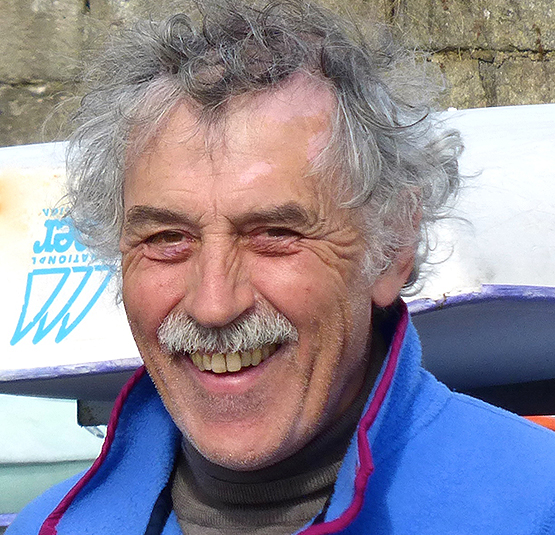 The mover and shaker. Alistair Rumball’s Irish National Sailing School in Dun Laoghaire is first port of call for many newcomers to sailing. Photo: W M Nixon
The mover and shaker. Alistair Rumball’s Irish National Sailing School in Dun Laoghaire is first port of call for many newcomers to sailing. Photo: W M Nixon
“Lynx has been a greater success than we could have ever dreamed of” he said. “She has been so booked out with people keen to learn about sailing a cruiser-racer that we haven’t been able to get as much actual racing with ISORA and so forth as we’d like. But for 2016, she’s being taken out of our Dun Laoghaire setup for long enough to be organised for a proper shot at the Volvo Round Ireland”.
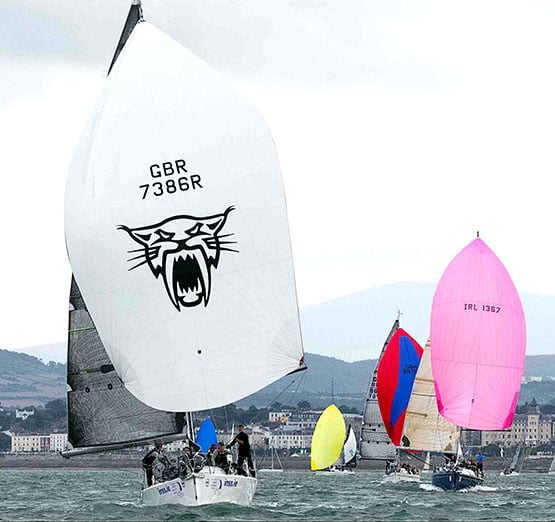
The double life of a Prima 38. The INSS’s Lynx in full racing mode in Dublin Bay (above), while below she is seen in early training mode as she takes a crew of beginners in cruiser-racing out for some formative experiences

As of last weekend in Limerick, there were just two crew places left aboard Lynx for this year’s Volvo Round Ireland on June 18th, and they’ve probably been snapped up by now. But the Rumball presentation underlined the fact that there are people out there who are mad keen to get into cruiser-racing, and it was up to ICRA to guide its members as to how best to tap into these wannabee sailors, instead of bleating all the time about how hard it is to find crew.
Des McWilliam leapt into the same theme, and gave us a crash course in how to make crewing on your boat more attractive to strangers. Admittedly the experience of seven years of acute economic recession have understandably made those who have kept boats in racing commission more than a little stressed. But if they want to reap the benefits of having struggled to stay in the boat-owning stream, then they have to make their cruiser-racers pleasanter to sail on, and more effective racing machines.
The McWilliam message was blunt in the extreme. “As a sailmaker in Ireland, each year I will race actively at many venues on upwards of 40 boats, both evenings and weekends. I will experience many different management and sailing styles. At the end of the year looking back, I usually realise that there might be only ten to a dozen boats out of that total of forty to which I would gladly and freely return for the good sport, the efficient sailing, the successful racing, the camaraderie – the fun. The rest of them are just work, involving duty visits. Please remember this when you are setting up the running of your boat, and trying to encourage people to sail with you.”
Des McWilliam of Crosshaven and Rory Staunton of Mayo. Des provided the meeting with some telling home truths about how attractive (or not) cruiser-racers throughout Ireland can be to sail on, while Rory Staunton led the charge in wondering why ORC and IRC cannot be amalgamated, and then went on to outline a new trailerable 33-footer he and an international group of friends are developing to make the incomparable west of Ireland a more accessible sailing area
We earned our lunch by going through an intensive session with Dobbs Davis of the Offshore Racing Congress, who had come to the conference with Zoran Grubisa to promote their measurement rule, which is used worldwide anywhere that IRC is not dominant, and in some key events such as the Rolex Sydney-Hobart Race, they are used in tandem, though IRC is currently the more-used system in that classic event.
It says everything about how Irish sailing punches way above its weight that these two guys thought it worth their while to come among us and evangelise for their system in a country which has a more-than-friendly relationship with the IRC and the people who run it. But it was fascinating stuff, making an input which added real spice to the day.
Davis is Chairman of the ORC’s Promotion & Development Committee, while Grubisa heads the Rating Officers Committee, and they run a system which is now the ISAF-approved rating method for the ISAF Offshore Worlds, which this year will be staged in Copenhagen in July, which as it happens is more or less the same time as the Royal Cork YC will be staging the new European IRC Championship in Volvo Cork Week at Crosshaven.
So the presence of the evangelists from the ORC at the ICRA conference could have opened up a right can of worms, but fair play to Dobbs Davis, he gave such an enthusiastic and lucid explanation of the completely transparent way in which ORC function that, for the time being at least, one’s instinctive loyalty to IRC was suspended out of intellectual curiosity.
Leading Offshore Racing Congress officers Zoran Grubisa (left) and Dobbs Davis were in Limerick to evangelise for the ORC Rating system
While IRC still has one or two hidden elements – the “Black Box” factor – with the transparency of ORC, you can always see how different inputs are effecting the final figure. One-design sailors may find all this utterly yawn-making, but as Davis pointed out, although there are so many successful cruiser-racer One-Design classes in America that ORC has yet to gain significant traction there despite being first set up in the US forty years ago, elsewhere in the world more and more people are coming to ORC as they enjoy watching boat innovation and performance analysis interacting to make their sailing more interesting and the results indicative of pure sailing ability.
The approachability of the ORC system was presented as one of its advantages
The slice of the cake worldwide for the different rating systems
But as we all know, where IRC and OCR are run side-by-side, despite the IRC’s hidden elements the two outcomes are often very similar. And in Ireland where we have a soft spot for the old S&3 34s which set world alight in 1969-73, the fact that the veteran though beautifully restored S&S 34 Quikpoint Azzura was overall winner of the Rolex-Sydney Hobart Race under OCR, after so nearly doing it on IRC, caused a bit of heart-searching. But nevertheless Rory Staunton from Mayo SC spoke for many when he demanded to know why IRC and ORC couldn’t get together and resolve their small differences for the general benefit of the offshore racing fraternity. Dobbs Davis said his door was always open, but that began to feel a bit too reminiscent of the current efforts to form a government, so we were glad enough to take a break for lunch and then return to the rating topic, but from an entirely different point of view
The inevitable expense in maximizing your boat’s performance potential under either IRC or ORC made the sheer economy of ICRA’s Progressive ECHO system seem immediately attractive, and the lead-in the afternoon session by SCORA Commodore Ronan Enright even more apposite. Because the fact is, you could run the Progressive ECHO Handicap System without even knowing what a boat looks like, let alone having her dimensions measured do the last millimtre.
Donal O’Sullivan of Dublin Bay SC, and Ronan Enright, Commodore SCORA, discussing sailing administration matters during the lunch break at Limerick. Enright went on to give an illuminating presentation about developments in Progressive ECHO Photo: W M Nixon
In the absence of ICRA’s ECHO supremo Denis Kiely - unavoidably absent for family reasons – Ronan Enright gave a quietly telling performance. It’s fascinating that though ECHO started life as the East Coast Handicap Organisation back around 1971-72, it’s now a nationwide service overseen by ICRA, and its most active area of development is in the cauldron of concentrated cruiser-racing which you find when the activities of Cork Habour and Kinsale are combined.
Basically, Progressive ECHO depends on the results of the most recent race, after which, if certain criteria have been fulfilled, the results are automatically re-computed to give boats a new rating based the supposition that they had all finished dead level on handicapped time. My own most recent experience of racing with it when it is being enthusiastically applied was in the Volvo Dun Laoghaire Regatta, which was a perfect test-bed for the system, as it was a compact series with the same fleet throughout.
The result is a series-long level of commitment by boats and crews who, under a more brutal system, would have seen their interest and enthusiasm flag after Day Two or even earlier. So really the message is: If we’re trying to get people to enjoy sailing and particularly to enjoy racing which is what the non-involved most easily comprehend, then Progressive ECHO is doing more to get bums on boats than anything else in Irish sailing, for believe me you have never seen anything quite so heart-warming as the response of a crew who, under One-Design or fixed handicap systems, had not been at the races at all, yet suddenly under Progressive ECHO they find they’ve recorded a win.
Which was all good news but perhaps the most interesting revelation of all from Ronan Enright was that the top IRC racers around Cork are now taking a closer interest in their Progressive ECHO showing than there are in their IRC results. For under IRC, they know they’ll be in the top six, but each post-race adjustment of Progressive ECHO gives them a very clear message about just how well or not they were really doing on the day.
Tom MacSweeney of this parish then hosted a forum which basically came down to how sailing can present a more friendly and accessible response to people who might be vaguely interested, and could be potential sailing enthusiasts. This involved him drawing on his training as a critical journalist, for as he admitted, when he first turned up with his first sailing boat – a Ruffian 23 – in Crosshaven, everyone from Denis Doyle downwards immediately made him welcome. But we can all think of non-assertive characters who are great sailors, yet if they hadn’t been in sailing families in the first place, they might not have taken up the sport at all owing to the sometime apparently closed nature of “yachting”.
We learned that very little of an Achill yawl is showing above the water after she capsizes. This is how they look in proper order
Allied to Des McWilliam’s incisive look at boats which you like to be aboard, and boats which you definitely don’t, and it all provided food for thought, as too did John Leech of Irish Water Safety with his no-nonsense presentation about a mature approach both to safety, and to being rescued. In an interesting mix of images, he showed us a photo of what happens to an Achill yawl when it capsizes. The result is an awful lot of rather waterlogged traditional boat under the surface, and only a little bit showing with the crew perched on top. As Des McWilliam was probably the only other person present with any idea of what an Schill yawl in full health looks like, the least we can do here is show you a photo of them in good sailing order. Meanwhile, John Leech concluded by saying that when you call out the ASR helicopters, think rather of how you can prevent your mast – if it’s still standing – from interfering with the rescue. Don’t for heaven’s sake use up emotional energy thinking about how much it all costs. They’re on standby all the time, and you the taxpayer have paid for them in the first place.
We concluded with Rory Staunton seeking interest and opinions for the new 33ft trailerable One-Design. While we all hope to get down to Clew Bay to sail the prototype this summer, could I suggest that one of the most exciting projects on the Irish cruiser-racer horizon is WIORA Week 2017 in the Aran Islands. So when they’ve finally got around to fixing a date, maybe the promoters of the new 33-footers could arrange to have a flotilla of them in Kilronan in 2017 to give the class a rocket-assisted launching.
Meanwhile this year’s WIORA West Coast Championship is under the auspices of the Royal Western of Ireland Yacht Club at Kilrush from June 29th to July 2nd. There’s so much extraordinary history in being able to write that simple bit of information that I reckon we’ll have to give it a complete blog in the future.
As for the ICRA Nationals, they’re at Howth from June 10th to 12th with both IRC and Progressive ECHO being used, while Volvo Cork Week comes up in July after the Volvo Round Ireland race has been tidied away in late June.
Although last Saturday’s Limerick gathering was essentially a wide-ranging conference, it was also the changeover to the new Commodore, with Simon McGibney taking on the mantle from the energetic and enthusiastic Nobby Reilly whose own boat, the Mills 36 Crazy Horse, was seen in virtually every event, and looked like heading for the win in Class at the ICRA Nats in Kinsale last June until new big winds swept George Sisk’s WOW to the fore. During Nobby’s busy time in the top office, ICRA’s activities and its reach steadily expand, while thanks to the persuasive efforts of Anthony O’Leary, a Commodore’s Cup team was assembled which regained the trophy in 2014.
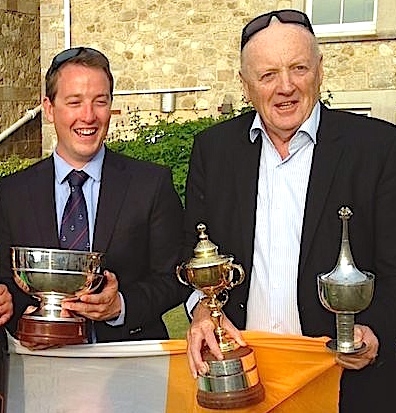 Ross MacDonald and ICRA Commodore Nobby Reilly at the Royal Yacht Squadron in Cowes in July 2014 after Ireland had won the Commodore’s Cup. At the ICRA Conference in Limerick last weekend, McDonald won a special award for his season’s results in 2015 with his X332 Equinox, while Nobby Reilly stood down after his successful years as Commodore, handing over the helm to Simon McGibney.
Ross MacDonald and ICRA Commodore Nobby Reilly at the Royal Yacht Squadron in Cowes in July 2014 after Ireland had won the Commodore’s Cup. At the ICRA Conference in Limerick last weekend, McDonald won a special award for his season’s results in 2015 with his X332 Equinox, while Nobby Reilly stood down after his successful years as Commodore, handing over the helm to Simon McGibney.
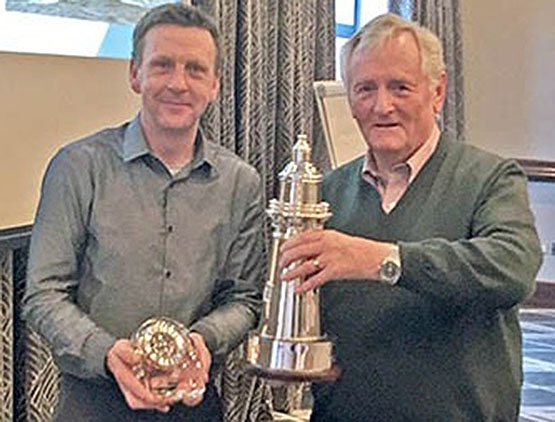
New ICRA Commodore Simom McGibney presents the “Boat of the Year” trophy to George Sisk of the Royal Irish Yacht Club, skipper of the Farr 42 WOW.
Work is going on behind the scenes to provide a strong defence this summer, but Anthony O’Leary wasn’t in Limerick to tell us about it, as he was away on his annual participation in America in the Viper 640 Championship, which just wouldn’t be the same if O’Leary wasn’t taking part - so much so that last year, he wasn’t present when his name came up as “Sailor of the Year” in Dublin, for he was away then too, Viper racing in the sun.
But other top sailors were there to round out the conference with the annual awards such as special performances by the likes of Dave Cullen with Checkmate XV and Ross Macdonald with Equinox and, while the ICRA Boat of the Year presentation, with warm acclamation, went to George Sisk of WOW, who not only admitted that his well-tested craft usually races with a crew of average age 53, but if he himself didn’t happen to be on board, the average age came down considerably………..And in case you think becoming ICRA Boat of the Year is all about glamour racing in sunshine, we close with a photo of WOW and the JPK 950 Alchimiste crawling towards the starting line for the Dun Laoghaire to Dingke race on the sort of damply windless evening that most folk would much prefer to spend comfortably at home.
It isn’t always glamour and warm sunshine and pleasant breezes. 2015 ICRA Boat of the Year WOW on a damp and windless evening approaching the start of the 280-mile Dun Laoghaire to Dingle race with the JPK 960 Alchimiste.
Irish Sailing Can Take Heart From Dun Laoghaire School’s Latest Record Turnout
Anyone feeling a bit despondent about the future of Irish sailing, what with the disappointing weather for periods of the 2015 season, plus the lack of some really high profile international racing successes, would have had their sprits lifted mightily – and then some – by being around the Irish National Sailing School in Dun Laoghaire last weekend writes W M Nixon
This remarkable organisation, whose background and lively ongoing story we profiled on Afloat.ie on 16th May, have seen their records of numbers participating raised again and again through the summer as the numbers of trainees – from absolute beginners right up to wannabe offshore crews in the school’s Reflex 38 Lynx - have steadily increased, until a new peak was reached last Saturday when absolutely every boat in the club’s large and varied fleet was in constant action, with new participant levels achieved.
Other organisations in the sailing school sector used to wonder in admiration after the INSS began to get regular turnouts of more than 150 schoolchildren per day – when we were visiting on Monday May 10th, 185 schoolkids had been bussed down from Maynooth and were having the time of their lives afloat, many for the very first time.
Nevertheless, while 185 or even 190 participants in the INSS’s schoolchildren division were fairly frequent occurrences, it wasn’t until last Saturday - a great and golden day whatever the weather - that they finally surpassed the 200 mark for members of their Junior Club - aged 7 and over – afloat and learning how best to enjoy the wonders of boats and sailing.
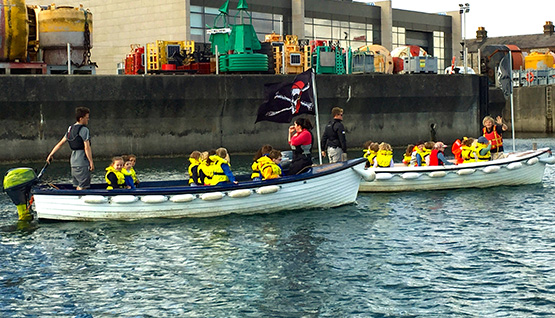 You get them into sailing in gentle stages. With toddlers and infants, just going out on a boat with a feeling of safety is a good first stage – this is Muriel Rumball (lead boat) with the most junior class – some of their parents may themselves be afloat with the INSS learning to sail in larger craft.
You get them into sailing in gentle stages. With toddlers and infants, just going out on a boat with a feeling of safety is a good first stage – this is Muriel Rumball (lead boat) with the most junior class – some of their parents may themselves be afloat with the INSS learning to sail in larger craft.
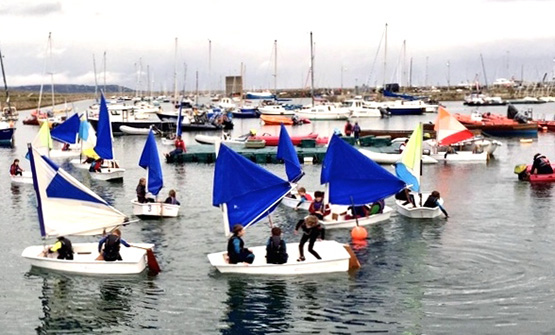 The first stages in sailing should be more about manageability than technical tuning – an Optimist with its sprit out of use lends itself well to fun afloat while gently familiarising the kids with the basics of sailing and getting on with others in the confines of a boat.
The first stages in sailing should be more about manageability than technical tuning – an Optimist with its sprit out of use lends itself well to fun afloat while gently familiarising the kids with the basics of sailing and getting on with others in the confines of a boat.
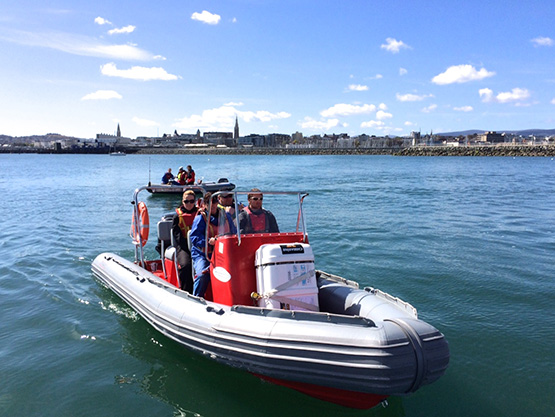 The powerful RIB Sting could be a lethal weapon in the wrong hands, but as she is one of the boats in the INSS Powerboat Course, her competent use is a feature of the school’s activities.
The powerful RIB Sting could be a lethal weapon in the wrong hands, but as she is one of the boats in the INSS Powerboat Course, her competent use is a feature of the school’s activities.
But that was only the start of it, for the school’s popular National Powerboat Course was running for the whole weekend with full turnouts, while the rest of the Schools’ sailing fleet, including 1720s and the Reflex 38 offshore racer, had more than 30 out in adult beginner training courses.
In our report of May 15th, we particularly remembered being in at the beginning of the historic first committee meeting of the newest club in Ireland, the Irish National Sailing Club, which enables the Sailing School alumni to take part in official regattas anywhere, and other open events, for the princely annual subscription of €10.
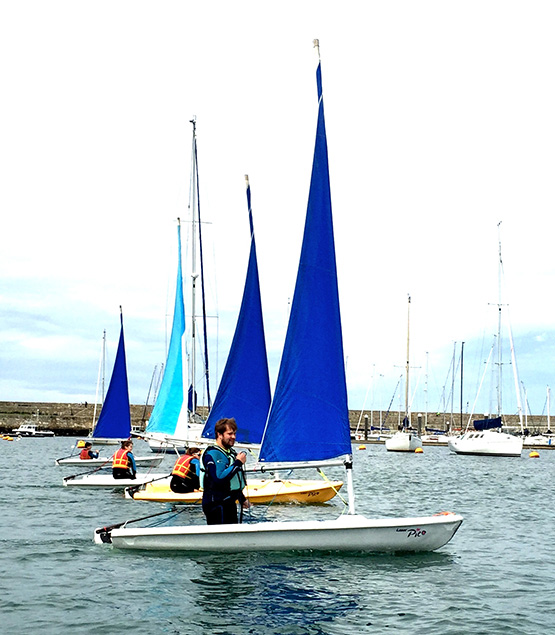 The highly durable Pico is one of the key boats in the INSS’s intermediate courses
The highly durable Pico is one of the key boats in the INSS’s intermediate courses
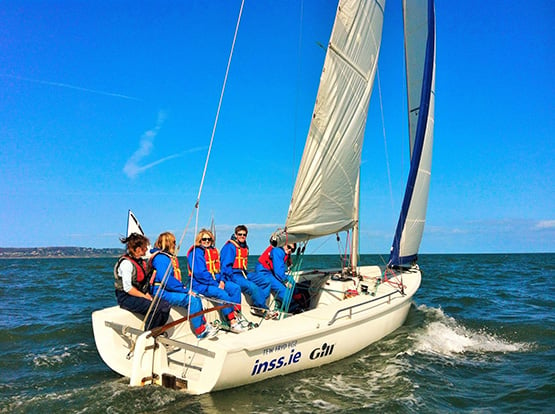 When Tony Castro designed the 1720 Sportboat for a group of Cork Harbour performance enthusiasts back in 1994, he can scarcely have imagined that twenty-one years later a couple of them would be providing ideal training craft for a busy sailing school in Dun Laoghaire
When Tony Castro designed the 1720 Sportboat for a group of Cork Harbour performance enthusiasts back in 1994, he can scarcely have imagined that twenty-one years later a couple of them would be providing ideal training craft for a busy sailing school in Dun Laoghaire
But so worthwhile has the growth and development of the INSC been during 2015 that its members have mustered sufficient numbers to stage their own proper races, and this line of progress also reached a new level on Saturday with the club staging the first INSC Mini-Regatta, with racing for its dinghy classes and well-used Squib fleet.
The regatta even had celebrity participation with noted former international athlete, Senator Eamonn Coughlan, taking part to film part of a documentary called Super Fit Seniors, recording the rapidly improving performance afloat of an 83-year-old whose name we’ve promised not to reveal until the programme is due to be broadcast, but we are allowed to say that if the national policy declares that “Sailing is a Sport for Life”, then on Saturday the INSS was proving it in abundance.
 First committee meeting of the Irish National Sailing Club on Monday May 10th 2015. The committee and school management of the newly-formed Club are (left to right) Glyn Williams (foreground), Muriel Rumball, Joan Sheffield, Caroline Herron, Robin Jones, Alistair Rumball, Kenneth Rumball, Garrett O'Malley, Dermot Igoe, Heather Blay and Mary Beck. Photo: W M Nixon
First committee meeting of the Irish National Sailing Club on Monday May 10th 2015. The committee and school management of the newly-formed Club are (left to right) Glyn Williams (foreground), Muriel Rumball, Joan Sheffield, Caroline Herron, Robin Jones, Alistair Rumball, Kenneth Rumball, Garrett O'Malley, Dermot Igoe, Heather Blay and Mary Beck. Photo: W M Nixon
Such is the stature of the Irish National Sailing School that it has been selected as the venue for one of the key assemblies in the up-coming series of Irish Sailing Association Regional Cluster Development Meetings, which seek to improve inter-club relationships and facilitate regional co-operation for the mutual benefit of the many and varied club memberships in specific areas.
The ISA East and Southeast Regional Development Officer Sarah-Louise Rossiter will be holding the meeting for sailing and yacht clubs in the Dublin South Cluster in the Irish National Sailing School from 7.0pm to 9.0pm on Wednesday October 7th.
We can only hope that some of the stardust now exuding from the INSS will waft on to those from other clubs. Alistair Rumball, founder of the INSS way back in 1974, helpfully explains how it’s done: “There’s nothing special to it. You just have to have everyone prepared to work 15 hours a day seven days a week, and be mad keen about teaching and sailing. That’s all it is. Simple as that really”.
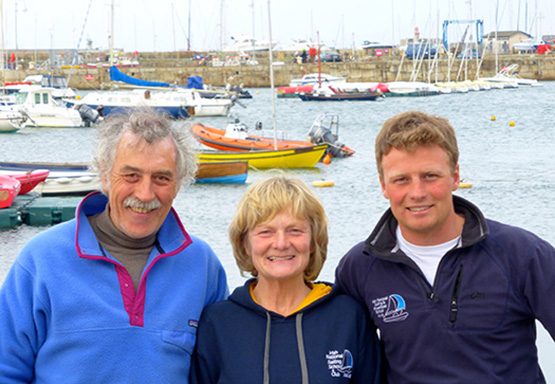
The National Sailing School’s Alistair and Muriel Rumball and their son Kenneth. “You just have to have everyone prepared to work 15 hours a day seven days a week, and be mad keen about teaching and sailing. That’s all it is. Simple as that really”.
#dlregatta – With the Kinsale ICRA Nats/Sovereigns Trophy 2015 very successfully concluded last weekend, and a classic Dun Laoghaire to Dingle Race put stylishly in place before that, the feeling of another sailing summer busily in progress is all-pervasive. But while the image projected may well be one of stately progress by the cruiser-racer fleets along the Irish coast, taking in an offshore race here and a regatta there with much leisurely cruising in between, the reality is usually otherwise. For those boats doing significant segments of the programme, it's a case of fitting chosen events into the usual hectic early summer life of work and family commitments and exams and everything else, with the re-location of boats to the next venue being a hurried task undertaken by delivery crews.
Next week sees the mid-season peak of the sailing summer, with the four day Volvo Dun Laoghaire Regatta 2015 in Dublin Bay from Thursday July 9th to Sunday July 12th. In a way it is an amalgamation of all that has has already occurred in this year's season, together with new elements to make it a unique sailfest which celebrates the fact that the citizens of Ireland's capital city and their guests can be conveniently sailing and racing within a very short distance of the heart of town. W M Nixon sets the scene
In the dozen or so years since its inception, the biennial Volvo Dun Laoghaire Regatta has settled itself firmly into the sailing scene as an exceptionally varied event in terms of the boats and classes taking part. There are five regular cruiser-racer classes, plus an offshore division, fourteen one design keelboat classes, and nine dinghy classes. And although there are contenders from Ireland's north coast and from the Cork area and south coast too, together with one gallant entry from Galway, it is essentially an Irish Sea Sailfest, though with a remarkably strong Scottish presence.
However, it was on the coast of Wales at 8.0pm last night that this sailing celebration began, with an ISORA Race starting in Holyhead and heading for Dun Laoghaire to set this large and complex programme into action towards a culmination on Dublin Bay in eight days time with the conclusion of VDLR2015.
2015 marks the Bicentennial of the Royal Dee YC, which was founded in 1815 on the Cheshire shores of the River Dee estuary where northwest England marches with northeast Wales. Originally the Dee Yacht Club (and founded, it's said, a month or two before the Royal Yacht Squadron came into being in the south of England, making the RDYC the second-oldest Royal yacht club in England after the Royal Thames), the Cheshire club became the Royal Dee YC in 1847.
Although the great prosperity of Liverpool in the 19th century saw the club's fleet of substantial yachts gathered in the Dee and then increasingly in the Mersey, by the late 1900s it was looking to the Menai Straits area as the focus of its keelboat events. As well, the completion of Holyhead breakwater in 1873 added a new and important harbour to its list of possible big boat sailing locations, and there was an increase in the number of cross-channel "matches" which the Royal Dee and the Royal Mersey, in conjunction with the Dublin Bay clubs, had already been running for some years.

A Royal Alfred YC cross-channel match from Dublin Bay to Holyhead gets under way in 1888. Cross-channel links were strong in the latter half of the 19th Century, and with the new breakwater completed at Holyhead in 1873, a new venue was available both for the Irish clubs and those on the other side such as the Royal Dee and the Royal Mersey

The bicentenary logo of the Royal Dee YC. In 1815, this club on the Cheshire coast was founded shortly before the Royal Yacht Squadron in the souh of England, whose Bicentennial is being celebrated at the end of July.

Dun Laoghaire saw its first regatta staged in 1828, and participation by yachts from the northwest of England and North Wales was regularly recorded. This is the Royal St George YC regatta of 1871.
So when we say that the Royal Dee has always been a stalwart of offshore racing in the Irish Sea, we're not referring to a story spanning only the 20th and 21st Centuries. On the contrary, it goes well back into the 1800s. And now, with the revival of keelboat sailing in the Mersey with several of Liverpool's myriad docks being given over to recreational use, we have in a sense come full circle with enthusiastic Dublin Bay support of the Bicentennial celebrations reflecting sailing links which go back almost 200 years
The Lyver Trophy is the Royal Dee's premier offshore challenge, and this year it is special, as it's a fully-accredited RORC event counting for points in the annual championship, and a highlight of the ISORA Programme 2015. It's start scheduled for yesterday evening in Holyhead will see the fleet – mostly regular ISORA contenders – sail a course of at least a hundred miles before finishing in Dun Laoghaire. Then as VDLR 2015 gets under way, races in it, combined with the Lyver Trophy results, will count as part of a series towards finding an overall winner of the RDYC Bicentennial Trophy.
Only entrants in the Lyver Trophy race are eligible, and for that race itself – which can be followed on the Averycrest Yellowbrick Tracker - the favourite has to be the Shanahan family's J/109 Ruth, still buoyed up by her great victory in the Dun Laoghaire to Dingle Race three weeks ago.

Back in The Bay – the Shanahan family's J/109 Ruth will be back in her home waters of Dublin Bay after winning the Dun Laoghaire to Dingle Race and completing the Lyver Trophy Race from Holyhead which started last night. Photo: David O'Brien
At the other end of the size scale, the VDLR2015 Dublin Bay programme includes several dinghy classes, and the biggest fleet will be mustered by the International GP 14s, who have designated the racing in Dublin Bay as their Leinster Championship. In an interview with Sailing on Saturday in March, VDLR Chairman Tim Goodbody emphasised that, overall, the event should be seen as a regatta rather than a championship, and for most boats that's just what it will be. But the GP 14s with their great esprit de corps have always done things their own way, and with their compact boat size – albeit comprising a large fleet of dinghies – they reckon they can get in a proper championship while sharing in the fun of the event.
 The brothers John and Donal McGuinness of Moville Sailing Club in Donegal are expected to be among the pace-setters in the GP 14 class with their superb Alistair Duffin-built boat. Photo: W M Nixon
The brothers John and Donal McGuinness of Moville Sailing Club in Donegal are expected to be among the pace-setters in the GP 14 class with their superb Alistair Duffin-built boat. Photo: W M Nixon

The GP 14 Ulsters 2015 were recently won on Lough Erne by Shane MacCarthy & Damian Bracken of Greystones
As to who is favourite, the McGuinness brothers – Donal and John - from Moville in Donegal, with their top-of-the-line Duffin boat built in Northern Ireland, have to be in the reckoning after being top Irish at last year's Worlds on Strangford Lough, but there's fresh blood in the fleet with the newest class developing at Youghal, while this year's recent Ulster Championship on Lough Erne was won by the Greystones duo of Shane MacCarthy and Damian Bracken.
The dozen and more boats coming south from Scotland, most of them substantial cruiser-racers, are testimony to a growing trend in sailing on Europe's Atlantic seaboard. Given a choice of venues, your average yachtie on this long coastline will incline to head south if at all possible. Other things being equal, it's reckoned the further south you go the warmer it is likely to be. And from the upper reaches of the Firth of Clyde, there are times when Dublin Bay might seem like the distant and sunny Mediterranean.
Maybe so, but we'd caution that much depends on the moods and location of that all-powerful weather determinant, the northern Polar Jetstream. In July, so long as it's well clear of Ireland -whether to the north or the south - we will have glorious high summer, and that occurred for the previous VDLR back in 2013, where the photos speak for themselves.
So we hope for the best in looking forward to welcoming a fleet of around 415 boats to Dun Laoghaire between July 9th and 12th, with all four of our in-harbour yacht clubs extending the hand of hospitality in a regatta tradition that goes right back to 1828. But while heritage and ceremonial are all very well in their place, it's the prospect of good sport which energises the participants and their sailing, and with several major contests already logged in 2015, what can we expect on the leaderboards next week?
At the top of the tree, Class 0 has formidable competition, including former Scottish champion Jonathan Anderson racing his XP38i Roxstar against the Royal Cork's Conor Phelan with the Ker 37 Jump Juice, which was one of the best performers in last year's ICRA Nationals at the same venue, and this year again became a force to be reckoned with as the breeze sharpened in the four day Kinsale ICRA Nats 2015/Sovereigns Cup a week ago.
 Freshly squeezed – her storming finish to last weekend's final race of the ICRA Nats/Sovereigns Cup at Kinsale makes Conor Phelan's Ker 37 Jump Juice one of the top contenders in the VDLR2015. Photo: David O'Brien
Freshly squeezed – her storming finish to last weekend's final race of the ICRA Nats/Sovereigns Cup at Kinsale makes Conor Phelan's Ker 37 Jump Juice one of the top contenders in the VDLR2015. Photo: David O'Brien
With a win in the final race, Jump Juice came in second to seasoned campaigner George Sisk's class overall winning Farr 42 WOW (RIYC), the pair of them in turn displacing the early leader, lightweight flyer Mills 36 Crazy Horse (ICRA Commodore Nobby Reilly & Alan Chambers, HYC) down to third in the final day's racing, so Crazy Horse will be hoping for a return of lighter breezes when racing starts next Thursday on Dublin Bay.
In the previous Volvo Dun Laoghaire Regatta in 2013, the most successful boat in was Nigel Biggs' much-modified Humphreys Half Tonner Checkmate XV, but this year the Biggs team is racing as Checkmate Sailing with the newest boat in the fleet, the Mark Mills-designed American-built C & C 30 OD Checkmate XVI. She may be only 30ft LOA, but she's such a hot piece of work with so many go-fast bells and whistles that she has a rating of 1.140 to put her in Class 0.
The oldest boat in the cruiser-racer fleets will be found in Class 3, where the 44ft Huff of Arklow is making an historic return to Dublin Bay racing. Originally built in 1951 by Jack Tyrrell of Arklow to a design by dinghy genius Uffa Fox, Huff is so-called because her concept is reckoned three-quarters Uffa Fox and one quarter Douglas Heard. The latter was the founding President of the Irish Dinghy Racing Association in 1946, and he later went onto to become Commodore of the Royal St George YC and a noted cruising and offshore racing enthusiast with this unusual boat, which is like a very enlarged Fying Fifteen with a lid – in fact, with her 30ft-plus waterline, she was described as a Flying Thirty. In recent years she has undergone a total restoration with Cremyll Keelboats near Plymouth in Devon, and Dominic Bridgeman of the Cremyll group will be racing her with trainee crews in her old home waters of Dublin Bay.

The Flying Thirty Huff of Arklow racing off Dublin Bay while under Douglas Heard's ownership in the 1950s. Built by Tyrrell's of Arklow in 1951, the hugely innovative Huff has recently had a major restoration, and will be making her return to Dublin Bay to take part in VDLR2015.
Among the newer boats on the bay, the 2013 champion Checkmate XV is still very much in the picture, but now she's owned by Howth's Dave Cullen, and took second overall in class in the Kinsale series a week ago. In Dun Laoghaire next week, she's with other Half Tonners at the lower end of the Class 2 rating band on 0.944, almost 200 rating points below the new Biggs boat. Class 2 also includes the Division 3 winner at Kinsale, Richard Colwell & Ronan Cobbe's Corby 25 Fusion (HYC) which bested VDLR 205 Chairman's Sigma 33 White Mischief in a real duel after they went into the final day's racing equal on points, while another Kinsale success story in the Class 2 lineup is Paddy Kyne's X302 Maximus from Howth, overall winner of the Portcullis Trophy for top ECHO boat.

Dave Cullen's modified Half Tonner Checkmate XV will be looking to take the top slot on Dublin Bay after being runner-up in Kinsale. Photo: David O'Brien
In between the two Checkmates on ratings, we find most of the cruiser-racer fleet, with Class 1 shaping up some interesting competition between the likes of Paul O'Higgins Corby 33 Rockabill (RIYC), Kenneth Rumball skippering the Irish National Sailing School's Reflex 38 Lynx, and two very sharp First 35s, Prima Luce (Burke, Lemass & Flynn, NYC & RIYC) and another former Scottish Series champion, John Corson (Clyde Cr C) with Salamander XXI.
This year's Scottish Series Champion and the Afloat.ie "Sailor of the Month" for May, Rob McConnell of Dunmore East, will certainly be racing in the VDLR 2015, but whether or not it's with his all-conquering A35 Fool's Gold (second in class at Kinsale) or aboard another boat (a Flying Fifteen) remains to be seen. And the Top Sailor Count doesn't end there, as there'll be at least four Olympic sailors involved in four different classes, with Robin Hennessy racing in what has all the marks of a quality International Dragon fleet against the likes of former Edinburgh Cup winner Martin Byrne, Annalise Murphy racing in the Moths which will surely be a change from the Water Wag which she raced with her mother Cathy MacAleavy (also another ex-Olympian) last time round, and Mark Mansfield helming John Maybury's J/109 Joker 2. After Joker 2's class overall win in Kinsale, we can expect a battle royal in the J/109s with boats of the calibre of Ruth for the National title fight.

The Shipman 28s find that the sport and socializing which the VDLR guarantees will provide some of their best racing of the year. Photo: VDLR
The J/109s are the queens of an impressive array of One Design keelboats which includes Sigma 33s (where VDLR 2015 Chairman Tim Goodbody's White Mischief is racing under the command of Paul McCarthy), Beneteau First 31.7s, Shipman 28s having one of their best gatherings of the year, Ruffian 23s with a good turnout, the attractive First 21s which are steadily gaining traction as a Dublin Bay class, and best OD keelboat turnout of all is by the Flying Fifteens, nearly all of them under the NYC flag.

Olympians all – in VDLR2013, Olympic sailors Cathy MacAleavey (1988) and her daughter Annalise Murphy (2012) raced the family Water Wag Mollie. But while Cathy will be sailing Mollie again this year, Annalise will be on her own racing a foiling International Moth.

Newest of the oldest – Adam Winkelmann and Doug Smith's new French built Water Wag No.46, Madameoiselle, has been launched in time for the regatta. Photo: Owen McNally

The Howth 17s of 1898 vintage will be the oldest class racing. Photo: David Branigan
Veteran classes include the IDRA 14s from 1946, the Glens from 1945, the Howth 17s of 1898 which pre-date the 1902 Water Wags, and the 1932 Mermaids, the latter being in the interesting position of no longer having an official division in Dun Laoghaire, yet it's a Dun Laoghaire skipper, Jonathan O'Rourke of the National, who continues to dominate the class both at home and away.
With large fleet numbers afloat guaranteed, the shoreside programme is appropriately busy, with the official side of each day's racing concluded by the evening's daily prize-giving at one of the four waterfront clubs. But with so many sailors involved, there'll be action in all the clubs – and at other establishments in Dun Laoghaire - throughout the week. The scene is set, let the party begin at a venue which has been staging regattas since 1828.
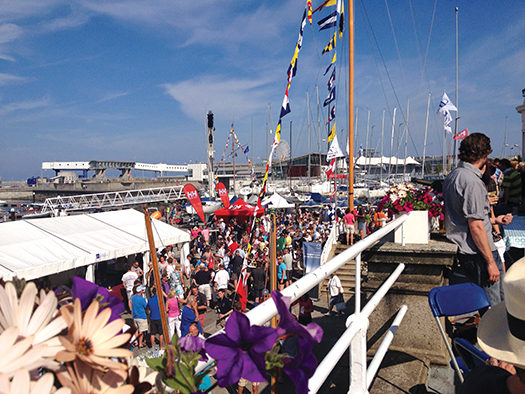
When the summer comes, the après sailing at the VDLR is world class. Photo: VDLR
Further reading:
Download the full entry list for Dun Laoghaire Regatta 2015 class by class below
Download the Sailing Instrcutions for Dun Laoghaire Regatta 2015 HERE
- Dun Laoghaire Regatta
- Volvo Dun Laoghaire Regatta
- Royal St George Yacht Club
- Royal Irish Yacht Club
- National Yacht Club
- ISORA
- Water Wags
- Royal Alfred Yacht Club
- yellowbrick
- GP 14
- Nigel Biggs
- George Sisk
- Annalise Murphy
- Half Tonners
- Tim Goodbody
- Mermaid
- Fool's Gold
- Dragon
- Irish National Sailing School
- Kenneth Rumball
- Dublin Bay
#inss – Last week, Sailing on Saturday featured the Royal Cork Yacht Club, the oldest in the world, as it comfortably donned the mantle of the ISA/Mitsubishi Motors Sailing Club of the Year 2015. This morning, we find ourselves involved with what may well be the newest sailing club in the world, the Irish National Sailing Club. It is certainly, thanks to being inaugurated nearly three months after Youghal SC was founded on 28th October 2014, the newest in Ireland. W M Nixon tries to explain it all as he finds himself in the world of Irish sailing's most complete dynamo.
Alistair Rumball is a Life Member of the Awkward Squad. Cage-rattling and pot-stirring are second nature to him. But it's not because of experiencing an unhappy childhood. On the contrary, while growing up in Malahide, his boyhood summers were bliss. He and his brother Arthur had as much sailing as they could want, fitted in between part-time jobs raising pocket-money with a morning picking potatoes at Dermot Dickie's farm along the Broadmeadow Estuary, followed by an afternoon of sailing the sea with the sun always shining, and then maybe an evening of club racing followed by the easy camaraderie among kids who are comfortable with boats.
It was an idyllic maritime environment which, over the years, has produced some of Ireland's top racing and cruising sailors. But while the young Rumball was no slouch on the race-course, the strongest feeling he had about sailing was the sheer fun of it all, the totally absorbing wonder of being in a boat and hauling on ropes to make sails change shape and help you along your chosen course over the always interesting sea.
Although he graduated from Trinity College Dublin as an engineer, he increasingly had this almost evangelical attitude to spreading the good news about the fun of sailing. And while he has something of a reputation – to say the least - for being confrontational, it's central to his contradictory character that he's an extremely good teacher. If somebody shows the slightest genuine enthusiasm about wanting to learn to sail, Alistair Rumball has been prepared to go to endless lengths to teach him or her to do so, and to do so with enjoyment.
Underlying that, we find the first of his gripes about the modern sailing scene. He reckons that it has become far too serious. Don't think for a moment, though, that he believes in a frivolous approach to boats and sailing. He's deadly serious about having everything just right as regards safety and function.
But once that's sorted, then he firmly believes that you should go out and enjoy it. He waxes lyrical about moments of sheer sailing ecstasy he has enjoyed in a wide variety of boats in many sailing locations worldwide. And whatever he may have formally set out to be in a professional career, his working life has been spent in and around boats, getting people introduced to boats and out afloat, sometimes on an almost industrial scale.
Time was when sailing skills were something you acquired by a sort of osmosis through family tradition, club opportunities, and friendship examples. That's mostly how Rumball himself learned to handle a sailing boat. But he seems to have this almost messianic zeal to teach people to sail, and he became convinced that the future lay in more structured training with a proper syllabus.
Having taken a long hard look at the population distribution of the Greater Dublin area and where they might best get afloat in worthwhile numbers, in 1978 he acquired the assets of a moribund organisation, the Dun Laoghaire Sailing School, and soon found himself giving his first lessons to two pupils using a fibreglass-clinker Darragh 14 knockabout sailing dinghy which they'd launched from the public slipway in the Coal Harbour in Dun Laoghaire. The long journey had started towards an organisation whose activities today today include top-of-the-line race training in 1720s in winning mode:
The majestic granite harbour of Dun Laoghaire was a cold place in 1978 for any young enthusiasts trying to set up an independent sailing school on a commercial basis. For the powers that be, sailing was something to be learned through family and clubs under the Junior Training Programme of the Irish Yachting Association. If you were a young person or adult from a non-sailing background but keen to learn, unless you'd an obliging and patient friend from within the sailing establishment, the expectation was that you'd take yourself off to somewhere far away like the Glenans Ireland bases in Baltimore and Bere Island and Clew Bay, and eventually reappear after a decent interval with enough experience, newfound ability and contacts to make the grade in the Dublin Bay sailing scene, where the very thought of a raw in-harbour sailing school for outsiders seemed distasteful to the establishment.
Yet hidden away in the southwest corner of Dun Laoghaire harbour, here was this gadfly of the sailing scene, Can–do Alistair with his rough and ready sailing school enthusiastically recruiting pupils anywhere and everywhere, and taking them afloat in boats which may not have been in the most pristine condition, and certainly set sails which would not be winners on the race course, yet they were safe and able, and so were he and his instructors.
Over the years, an entire cohort of people, mainly from Dublin but also from all over Ireland with a useful smattering of pupils from abroad, came to boats and sailing thanks to this wild-haired character whose love of his demanding work shone through everything he did.
Gradually the fleet expanded, and so too did the "Rumball Group's" activities, even though the very limited availability of premises on the Dun Laoghaire waterfront meant that every little square foot they had always seemed to serve at least three different purposes. But they were getting there, they opened a retail outlet in the town to sell boat gear and equipment which became Viking Marine, the school promoted itself to being the Irish National Sailing School, and they were well settled in place, using every inch of space on the ground floor of the interesting little building on the southwest corner of the harbour which used to be the Nautical College.

The man and his machines – Alistair Rumball and his chariot outside the Irish National Sailing School's HQ in Dun Laoghaire. Photo: W M Nixon
Centuries ago, seafaring education was given a significant role in Irish life in the late 1700s, the 1800s, and the early 1900s with the old Marine School a fine building on the south quays in Dublin. But its premises were re-allocated for development purposes and the school itself had its final home in Clontarf before being absorbed only as a vague memory into what is now Mount Temple Comprehensive school.
These days, the marine education focus has moved to Cork with the fabulous new National Maritime College in Ringaskiddy, but for that low period in Irish maritime life in the mid 20th century, one of the few keepers of the flame was Captain Tom Walsh who operated the little Nautical College in this fairly inconspicuous Office of Public Works building now hidden away behind the Dun Laoghaire Motor Yacht Club.

Captain Tom Walsh in teaching mode in 1957 in the INSS building when it was the Nautical College.

The 110ft barquentine which Jack Tyrrell designed for Captain Tom Walsh's Nautical College in 1954 in the hope that it would inspire the building of an Irish Tall Ship
It was the gallant Captain Walsh who in 1954 commissioned Jack Tyrrell of Arklow to design a 110ft sailing ship – a barquentine – to be Ireland's very own tall ship, our first sailing training vessel. God bless the good captain, but he was convinced that if he could just get someone in Government to see these inspiring plans, then such a ship would be on the way.
You can imagine just how far such a visionary idea travelled in the deadly dull Ireland of the 1950s. Far from getting a proper training ship built, Captain Walsh had enough trouble keeping his college in being. Yet he was a gentleman and enthusiast to the end, and after retirement he augmented his pension by testing compasses in yachts, which I remember well as he did it for me with a little cruiser in 1981. The only mutually convenient time it could be done was on a Saturday evening, and I'd to get the boat from Howth to Dun Laoghaire to do it, but the actual swinging of the compass by Tom Walsh was such a pleasant and educational experience that any thoughts of being at some Saturday night party were entirely banished.
So when you go into the main premises of the Irish National Sailing School today, it's natural to remember Captain Tom Walsh, and I like to think that he would thoroughly approve of the old building's current usage, for Alistair Rumball and his team are mighty busy during what must sometimes be an 18-hour day, and just this week – before the sailing season is really fully under way – Monday was typical, with 185 schoolkids bussed down from Maynooth for a day's coaching afloat, followed by all sorts of gatherings including a committee meeting of the newly-formed Irish National Sailing Club.
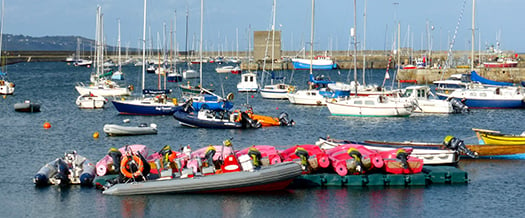
Space is so constrained that a floating dinghy park has to be used to store the smaller craft. Photo: W M Nixon
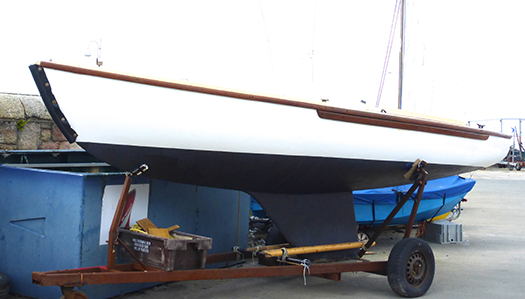
Thanks to the special INSS fendering devised by Arthur Rumball, this 35-year-old Squib has survived many seasons of tough teaching in good order. Photo: W M Nixon
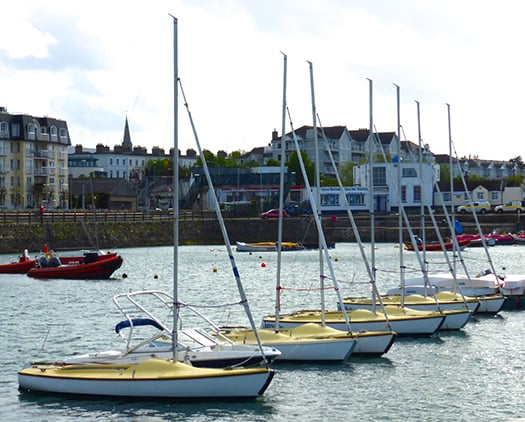
To economise on space, the Squibs berthed here, with the INSS building in the background, are double-moored. Photo: W M Nixon
Of which more anon, for this bare outline gives only a hint of the INSS's complex programme. The Rumball theme is that you have to keep operations and facilities flexible to cope with fluctuating demand, for at the height of the season the school is operating a fleet of 200 boats ranging from kayaks through sailing dinghies of increasing size, then on into keelboats of which some well-fendered Squibs are the workhorses while 1720s provide the glamour input, and finally at the top of the tree there's the Reflex 38 Lynx, bought from Galway this past winter, and becoming part of a programme headed by Alistair's son Kenneth – a Silver Youth Medallist in the 420 – who is now a fully-qualified offshore racing pro teacher, but also races the 1720s while being main operations director of a school which has five full–time employees, but in all has sixty staff at the height of the season.
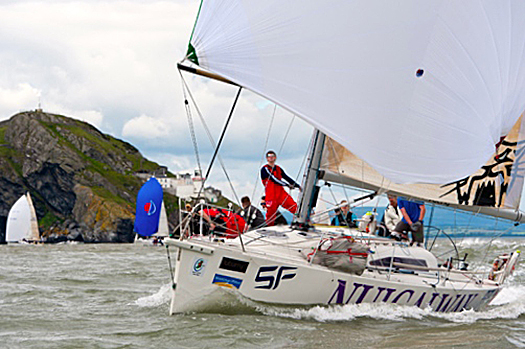
The latest addition to the INSS fleet is the Reflex 38 Lynx, seen here racing for NUI Galway during the Round Ireland. In 2015, Lynx has already scored a second overall in ISORA racing skippered by Kenneth Rumball.
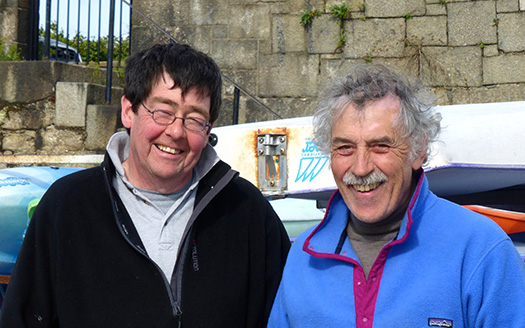
Brothers in business – seen here with his brother Alistair, Arthur Rumball (left) runs the often very busy INSS boat maintenance facility. Photo: W M Nixon
As to shoreside facilities, each summer they set up an additional seasonal summer base to the west of the West Pier with top-of the-line Portakabins at Salthill to provide facilities for those sailing dinghies and kayaks, and in addition the INSS have their own boat-maintenance unit under Arthur Rumball beside the boatyard in the Coal Harbour.
So an impressive amount of things have happened since 1978, the best of them surely being that Alistair persuaded Muriel, a country girl from one of the most beautiful parts of County Carlow, to marry him. For Muriel is a teacher by profession, and adept at being the peace-maker who smooths the waters after Alistair has been making waves, which even now still seems to be just about all the time.
That said, he gives the impression of having so many chips on his shoulder about the perceived opposition to his ventures by those in authority that you begin to think it might be just a bit of an act, for underneath it all he has a heart of gold, yet with the spirit of a lion who will fight the good fight to defend his territory and the interests of his family, friends, trainees and businesses.
The quality of the man was well revealed when the economic recession struck. At the height of the boom years, the Irish National Sailing School had a throughput of more than 2,500 people per month coming new to sailing, and it had become a vibrant and trendy part of the recreational fabric of good-time Dublin. Then around 2008, the economy went into free-fall. But the INSS survived both by making severe cutbacks in everything, and utilising another string in Alistair's bow.
Because of his ready enthusiasm to undertake just about everything and anything to do with boats, back in 1982 he'd looked after some waterborne scenes with classic small craft for the Channel 4 TV comedy-drama series The Irish RM, starring Peter Bowles and Bryan Murray, which went out between 1983 and 1985. It was grand at the time, but thirty years down the line it now seems to have a dose and more of the Paddywhackery about it. However, that was neither here nor there for Alistair Rumball in 1982, for it gave him a lucrative little sideline, and over the years since he has been the man to go to if you want to set up boats and sailing ship scenes in the Irish movie-making business.
So it's ironic, when we remember that Malahide was where the rather mouldy old Vikings of Dublin made their last base after their city had been captured by the Normans in 1171, that it should be a Malahide boy who has emerged as the behind-the-scenes captain of ships for the filming of the blockbuster series Vikings.

When you've spent most of your working life teaching people to sail, tutoring Thespian Viking crewmen on a Wicklow lake is just an ordinary part of another day at the office.
It has all been happening for some years now up in the Wicklow mountains and out on the Wicklow lakes, which have passed themselves off very well as Norwegian fjords, yet can double quite effectively as the coastal and riverside scenery of the many places where the Norwegian Vikings wreaked mayhem.
Who knows, but maybe with the passage of time the epic Vikings series will come to be seen as the epitome of Scandiwhackery, but for now, it certainly does the business . For as the Irish economy fell off a cliff, Alistair Rumball soared aloft in creating, managing, and manoeuvring a very authentic and substantial Viking longship flotilla which has provided a proper Tinseltown income to make all things possible, while helping underwrite the future of the Irish National Sailing School.
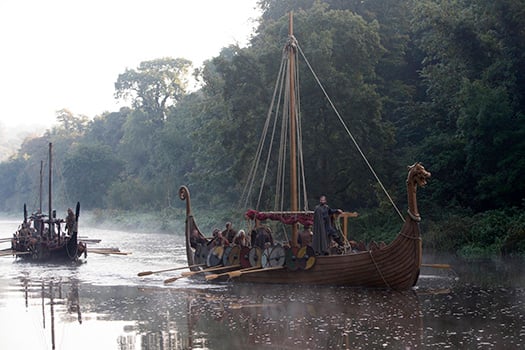
Lough Dan in County Wicklow - where Erskine Childers first sailed around 1890 – has proved remarkably versatile in providing backgrounds for the Vikings which could either be Norway itself, or else the shores of places they are raiding
But it's extraordinarily demanding and time-consuming work, even if he has a staff of 150 specialists up in the Wicklow hills, and after a year or two it became clear that he was trying to do too much. So four years ago his son Kenneth, who is now 27 and was at the time working as an accountant, moved in to take over the direction of the sailing school, and as the recession has started to recede – last year they had monthly numbers pushing back towards the 2,000 mark - Kenneth's energetic and all-encompassing input is seeing the school increasing the scale of its operations, particularly in what might be called the post-graduate side with the development of 1720s at top race level. Now the acquisition of Lynx has developed things further - she has already made what was a rather hasty debut in the first ISORA of the year, but despite being only minutes out of the box, they placed second overall, and that only by six minutes.
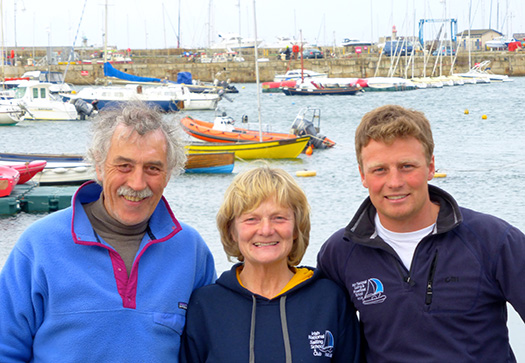
Alistair, Muriel and Kenneth Rumball. Photo: W M Nixon
This placing of racing as a natural part of the INSS syllabus has in turn led to the need for an officially-constituted club to comply with race entry requirements. But in reality the INSS has had a genuine club atmosphere for years, indeed it has more of a truly club-like atmosphere than many a historically-constituted old yacht club. So it was only a formality to bring the Irish National Sailing Club into being in January 201, but it's for real, here's a pic of the Committee of the new club meeting in the old Tom Walsh building on Monday, and if you want to join, it will cost you the outrageous sum of €10.
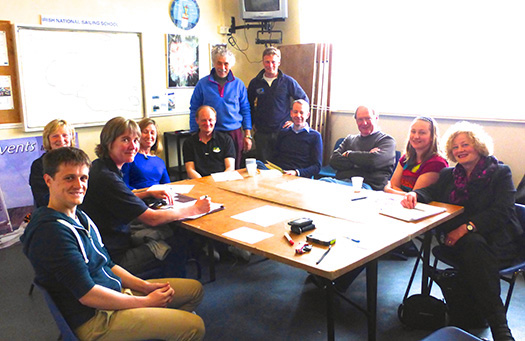
The committee and school management of the newly-formed Irish National Sailing Club are (left to right) Glyn Williams (foreground), Muriel Rumball, Joan Sheffield, Caroline Herron, Robin Jones, Alistair Rumball, Kenneth Rumball, Garrett O'Malley, Dermot Igoe, Heather Blay and Mary Beck. Photo: W M Nixon
As to how Alistair Rumball views the impending possible re-structuring of Dun Laoghaire as a cruise liner port, with inevitable limitations on the amount of sailing which can take place within the harbour, he is both an idealist and a realist.
Like many of us, he dearly wishes that this splendid granite creation could be seen as a cherished part of our heritage, not as something to be used to generate income to turn a crude profit or even just to pay its own maintenance costs. Rather, we'd ideally like to see it treated as a national asset to provide vital recreational space for everyone afloat and ashore.
But Alistair Rumball senses that the government's determination to use just about everything in public ownership to generate income will win the day, and he is already being realistic about what the regular if summer-emphasised arrival of cruise liners will mean.
In fact, he may even derive a certain sardonic satisfaction from seeing the Dun Laoghaire sailing establishment having to contemplate accepting conditions with which his school has complied ever since he began operating it.
"People should realise" he asserts, "that there are already two clearly-define shipping channels in Dun Laoghaire Harbour. One is from the harbour entrance to St Michael's Wharf, which will simply be retained if the cruise liners come. The other, much less widely known, is supposed to be from the harbour entrance to the berth at the Band Stand on the East Pier. Even at present, you are not meant to operate under sail in either of those channels, but an awful lot of boats do so."
"However, as we are a commercial operation, we have a strict policy of complying with regulations and carrying out our sail training and teaching operations in the western part of the harbour, clear of the main channel. So a cruise liner should not affect our in-harbour activities, while our larger craft going out into the bay will have to comply with shipping regulations in the entrance like everyone else".
Whatever happens, we may be sure that the Irish National Sailing School and the Irish National Sailing Club - and their splendid founder - will continue to be a thorn in the side of those who take themselves too seriously and have an inflated idea of their own importance. But if you've never been in a boat before and know nobody in sailing, yet feel a growing enthusiasm to go sailing in Dun Laoghaire, you now know where to go to experience the real thing.
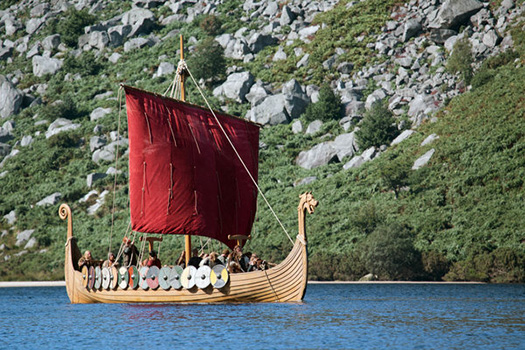
The other side of the INSS show – a Viking ship looking good on Lough Dan



























